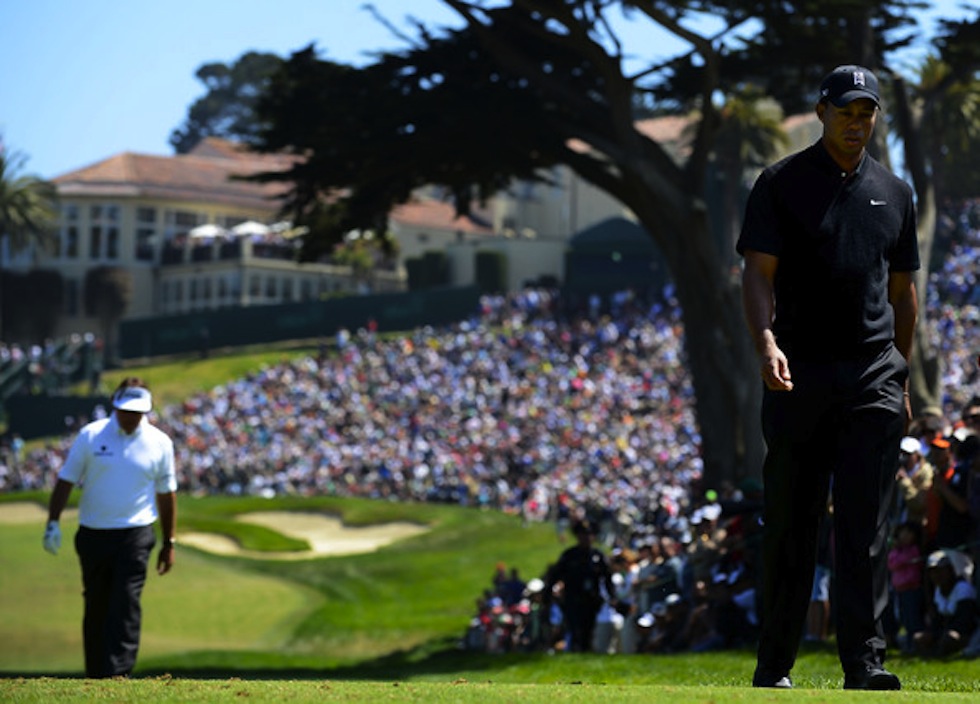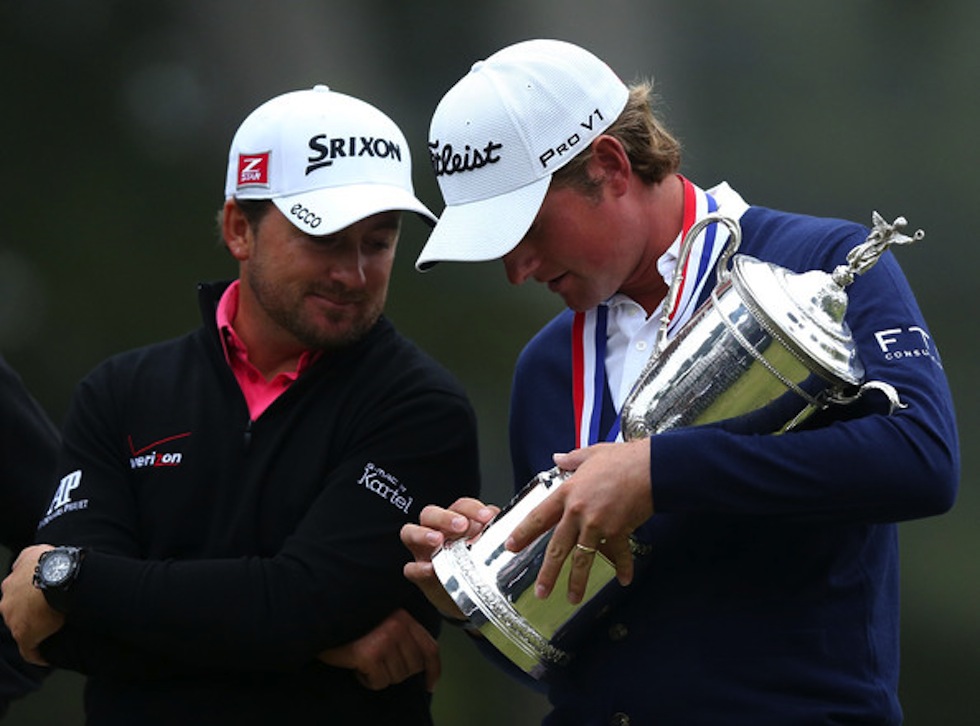 Another major championship is in the books and you know what that means. Another Lee Westwood backdoor top-10, another Tiger Woods weekend mini-meltdown, and another drunk lunatic hauled from the trophy presentation by Mike Davis.
Another major championship is in the books and you know what that means. Another Lee Westwood backdoor top-10, another Tiger Woods weekend mini-meltdown, and another drunk lunatic hauled from the trophy presentation by Mike Davis.
The Lake Course at Olympic Club put up a pretty tough test, producing the highest winning score since Oakmont in 2007. In fact, if you look past Oakmont and Winged Foot (2006), Webb Simpson’s +1 would be the highest winning score since Andy North won at Cherry Hills in 1978. After Rory McIlroy took advantage of moisture en route to a -16 last year, firm and fast was the name of the game this year, especially from Thursday through Saturday. A thick layer of fog blanketed the course on Sunday, and though players could stop the ball a bit easier, some of them struggled to actually take advantage of that fact (Tiger Woods being the most obvious example).
Though the three golfers who were really in it late (Simpson, 54-hole leader Jim Furyk, and 2010 U.S. Open champion Graeme McDowell) aren’t the most jovial cast of characters, the last few holes were some of the most exciting of the year. We got to see two golfers play the 18th hole, a hole that doesn’t require particularly high stakes to produce good television, needing a birdie. Three shots from 341 yards could have forced a playoff, but in the end Webb Simpson held them both off.
Here are five of the most interesting story-lines form the 2012 U.S. Open.
Number Five: The U.K. Trio
Rory McIlroy, Luke Donald, and Lee Westwood are the top three ranked players in the world, but they certainly didn’t play like it at Olympic. Grouped together the first two days, only Westwood made it to the weekend. Lee managed a top-10 finish even after a double bogey on the first hole of play, but he never seriously contended.
Westwood is now 39 years of age, and he’s already been through one half-decade long slump. He announced recently that he will be moving to the U.S. at the end of the year, and even he admitted, “I haven’t got that much time left at the top and I want to give myself the best chance of staying there as long as I can.” Though his record on the PGA Tour is not amazing for a former world number one, Lee has had a great European Tour run, and he’s made a career recently out of high finishes in top events. T3s in the Open Championship don’t leave much of a legacy though, and Lee knows that he will have to beat the best if he wants to remembered as one.

Though Rory McIlroy has had a rough few months, and some of the comparisons between him and a young Tiger Woods are beginning to show weak spots, he is still only 23, with plenty of time to grow as a golfer.
Luke Donald, on the other hand, is 34, and he isn’t likely to age as well as some of the longer hitters. Guys like Phil Mickelson and Vijay Singh (and, to a lesser extent, Fred Couples) have the length to stay relevant despite increasingly long courses and their own slowly decreasing distance off the tee. Donald, who is consistently among the shortest hitters on Tour, might have a smaller window than others. A few stats that don’t bode well for Donald: despite a major championship record that spans back to 1999, Donald has only finished inside the top 30 at a major 11 times, and he has missed a cut in at least one major every year since 2006.
Number Four: Firm and Fast
Once a year, the greatest golfers in the world gather somewhere in the United States, and battle it out on one of the world’s toughest courses. The rough is long, the greens are quick and hard, and the tees are back. It’s not a formula that would work every week, and it takes a special type of crazy to dream up some of the pin placements that the USGA uses, but for those four days in June, it’s a great test.
Some years they go too far, 2004 at Shinnecock being the prime example, and some years they take it a little too easy (though weather is usually reason for that). The name of the game might be “firm and fast”, but the operative phrase is “fair.”
This year they got it just about right. There were a few rough spots (the shaved area around 17 in particular was criticized after a Tiger Woods approach rolled well away from the green after what appeared to be a solid shot), but in general players praised the USGA for the course setup.

Number Three: The Amateurs
Though he came into the U.S. Open a virtual unknown, Beau Hossler was one of the most talked-about names of the event. After an even-par opening round and a score of two-under through his first 11 holes on Friday, Hossler briefly led the tournament. A poor finish knocked him out of the lead, but for a short moment in time, a 17-year-old was leading the hardest golf tournament in the world.
Despite another even-par round on Saturday, Hossler fell apart in the final round, even failing to reach his goal of low amateur. That award went to 18-year-old Jordan Spieth. Spieth, who made his PGA Tour debut in 2010 with a T16 finish at the Byron Nelson Championship, started with a pair of 74s to make the cut on the number. He followed that up with a one-under 69 and an even-par 70 to win the low amateur title. Spieth attends the University of Texas, the school Hossler has already pledged to attend, so expect to see some fireworks coming from that program over the next few years.
The only other amateur to make the cut was UCLA alum Patrick Cantlay, who turned pro immediately after the event. Cantlay, who entered the event as the top-ranked amateur in the world, already has a solid record. Last year Cantlay finished T21 at the U.S. Open, T9 at the Canadian Open, and shot a 60 (the lowest score ever shot by an amateur in a PGA Tour event) en route to a T24 finish at the Travelers Championship. Like Spieth, Cantlay made the cut on the number.

Number Two: Tiger and Phil
Tiger Woods, the current top-ranked American, and Phil Mickelson, a perennial U.S. Open competitor, went into the Open with some of the most fanfare. Tiger had won in his previous event, the Memorial, and Phil had cooled off some after a torrid beginning to his season.
They were paired together over the first two rounds, along with Bubba Watson, but they played very differently. Tiger Woods was downright masterful with his full swing in the early going, presumably leaving Sean Foley drooling from the sidelines. He was tied for the lead after 36 holes but fell apart on the weekend thanks to a touch of shoddy driving, terrible distance control, and a few bad breaks. He finished at +7, and after playing the first six holes at even par on Thursday and Friday, he was +9 on that tough stretch over the weekend.
Phil just never had it, and that was apparent straight from the get-go. After losing his golf ball on the first hole of play, Phil never really recovered. He sandwiched a 76 and a 78 around two 71s, and made only five birdies all week.
Number One: Webb Simpson
Going into the tournament, Webb Simpson was as well known for writing Bible verses on his hat as he was for nearly winning the FedExCup last year, but I suspect a major championship win will change that.
Though the word “plodder” was used often to describe Jim Furyk’s game, it is just as affective in describing that of Webb Simpson. He made a lot of pars (his only non-par on “easy” holes 16 and 17 was a third-round birdie on 17), and though he was +5 and six strokes back of the lead going into the weekend, he always looked in control.
Webb, who won twice last year within a three-week span at the Wyhdham Championship and the Deutsche Bank, picked up his first win of 2012, a win that saw him going -4 in tough conditions on the weekend to finish at +1.

Simpson started out a few groups in front of the leaders, and for a while it looked as if his posted lead in the clubhouse would not hold. After a tough +2 start through five, Simpson bogeyed four of his next five holes, and stayed steady at one-over. He watched from the clubhouse as leader Jim Furyk, after being given his second slow-play warning, duck-hooked a drive on the shortened 16th hole. Furyk bogeyed that fairly easy par-five, and when he couldn’t make up a shot on the 17th, he and Graeme McDowell went to the 18th tee together, each needing a birdie to force a playoff.
McDowell made par and Furyk bogeyed, making Webb Simpson the second Simpson to be victorious at the Olympic Club (after Scott Simpson won in 1987).
Closing and Your Thoughts?
Last week at Olympic was not a “classic” U.S. Open, but it sure was not the snooze-fest of 2011. We got to see several golfers come down the stretch with a chance to win, and Webb Simpson pulled it out. Graeme McDowell and Jim Furyk were both looking for their second U.S. Opens, but for the fifteenth major championship a first-time winner walked away with the hardware.
Tiger Woods went major-less yet again after a victorious pre-tournament tuneup, despite co-leading after 36 holes. Phil Mickelson again failed to putt out his nation’s championship, this time barely making the cut. And their group-mate, Masters champ Bubba Watson, missed the cut, but boy did he go down swinging.
As we go into the second half of the major season, golf seems to be in a good place. Though no one has dominated, all of the top players have won, and each looks to be in good form. Some of the aging veterans are playing well, and young guns like Rickie Fowler are beginning to break through. It should be an interesting year.
Photo Credits: © Ezra Shaw, © Stuart Franklin, © Harry How, © Andrew Redington.



1 thought on “Five Stories from Olympic”